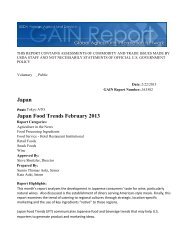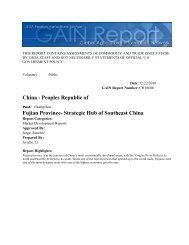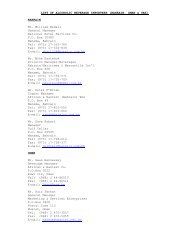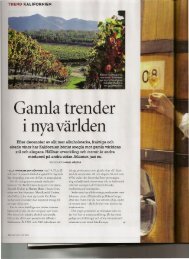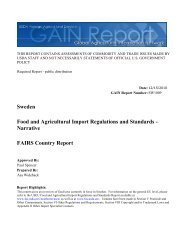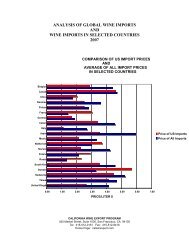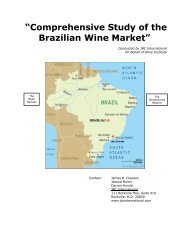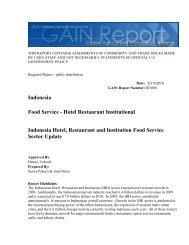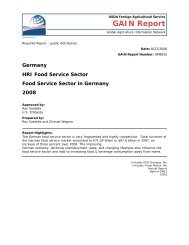FAIRS Country Report Food and Agricultural Import ... - GAIN
FAIRS Country Report Food and Agricultural Import ... - GAIN
FAIRS Country Report Food and Agricultural Import ... - GAIN
You also want an ePaper? Increase the reach of your titles
YUMPU automatically turns print PDFs into web optimized ePapers that Google loves.
Internet links identified in this report are intended to provide the reader direction to the basis of EU law,regulation, or st<strong>and</strong>ard to which Lithuania now defaults. Please work with your importer/buyer toensure current requirements are met.
Section I. <strong>Food</strong> Laws:In 2004 Lithuania joined the European Union <strong>and</strong> has adopted its law to implement in 2004 <strong>and</strong> adaptedEU Council Regulations by harmonizing Lithuanian laws EU regulations <strong>and</strong> st<strong>and</strong>ards. Lithuaniaadopted its national food law, “<strong>Food</strong> of the Republic of Lithuania Law,” in 2000 (04/04/2000, No. VIII-1608, National Gazette 2000), amended via No. 32-893; amended 06/06/2002, No. IX-937, Nationalgazette No. 64-2574; amended paragraphs 2,3,5,9,10, 11 <strong>and</strong> 12, 2003 No. 92-4139; published inNational gazette 2004, No. 93-3397, last edition in force since 12/06/2004.EU Commission Regulation (EC) 178/2002 established General <strong>Food</strong> Law principles <strong>and</strong> requirementsin order to harmonize EU member’s national requirements <strong>and</strong> ensure free safe trade of foods on the EUterritory (http://ec.europa.eu/food/food/foodlaw/principles/index_en.htm).EU regulations are employed for import of food products from the third countries according to theCommission Implementing Decision (2011/215/EU) of 4 April 2011 implementing Council Directive97/78/EC as regards transshipment at the border inspection post of introduction of consignments ofproducts intended for import into the Union or for third countries (OJ L90, 6.4.2011, page 50).Government of the Republic of Lithuania establishes a legal basis for food <strong>and</strong> market surveillance inLithuania. The Ministry of Agriculture, State <strong>Food</strong> <strong>and</strong> Veterinary Service (SFVS), Ministry of Health,<strong>and</strong> Ministry of Economy are institutions involved in development <strong>and</strong> enforcement of legislativenormative acts <strong>and</strong> regulations in Lithuania. The Ministry of Agriculture develops the guidelines <strong>and</strong>requirements designed to access the quality of food products (raw <strong>and</strong> processed), plants, <strong>and</strong> ecologicalfoods. State <strong>Food</strong> <strong>and</strong> Veterinary Service implements adapted food laws <strong>and</strong> regulations for the food(raw <strong>and</strong> processed, foodstuffs) control <strong>and</strong> monitoring. SFVS ensures the safety of supplied foods toLithuania <strong>and</strong> free movement throughout EU territory by ensuring quality, st<strong>and</strong>ards, labeling <strong>and</strong> otherrequirements in compliance with EU <strong>and</strong> Lithuania laws <strong>and</strong> regulations.<strong>Food</strong> quality <strong>and</strong> food safety policy implemented in Lithuania are approved by the order of the Ministerof Agriculture <strong>and</strong> regarded as <strong>Food</strong> Safety Strategy of the Republic of Lithuania (2001) <strong>and</strong> National<strong>Food</strong> <strong>and</strong> Nutrition Strategy <strong>and</strong> the Implementation Plan for 2003-2010 (2003). The <strong>Food</strong> SafetyStrategy enforces implementation of EU Council laws <strong>and</strong> regulations into legal system of Lithuania asa part of EU state member obligations by ensuring safeness of food <strong>and</strong> feed stuffs, phyto-sanitary,veterinary, activities of the laboratories, animal identification <strong>and</strong> registration, animal welfare, <strong>and</strong> statecontrol system. National <strong>Food</strong> <strong>and</strong> Nutrition Strategy is developed to foster quality <strong>and</strong> food safety offood products, sustainable food system in order to promote healthy nutrition <strong>and</strong> prevent diseasedevelopment in Lithuanian population caused by inadequate nutrition <strong>and</strong> food products.Ministry ofAgricultureGedimino av. 19State <strong>Food</strong> <strong>and</strong>VeterinaryServiceMinistry ofHealthVilnius str. 33,Ministry ofEconomyGedimino Ave. 38 / Vasario
(Lelevelio 6),LT-01103 VilniusLithuaniaPh: +370 5239 1111Fax: +370 5239 1212Email: zum@zum.ltSiesikų str. 19,LT-07170 Vilnius.LithuaniaPh: +370 52404361Fax: +370 52404362Email: vvt@vet.ltLT-01506 VilniusLithuaniaPh: +370 8006 6004+370 5268 5110Fax: +370 5266 1402Email:ministerija@sam.lt16-osios st. 2, LT-01104VilniusLithuaniaPh: +370 5262 5515+370 5262 6584Fax: +370 5262 3974Email: kanc@ukmin.ltThe Ministry of Economy ensures the implementation of the EU market policy in Lithuania. Themovement of the food freely to Lithuania <strong>and</strong> EU is regulated by Law on Product Safety, Regulation forthe Removal of Obstacles to Free Movement of Goods, Regulations for the Designation <strong>and</strong>Notification of Testing Laboratories <strong>and</strong> Certification <strong>and</strong> Control Bodies, Regulations for the FreeMovement of Goods <strong>and</strong> Exchange of Information about National Measures, Regulations for theExchange of Information about St<strong>and</strong>ards, Technical Regulations <strong>and</strong> Conformity AssessmentProcedures, <strong>and</strong> Law on the Conformity Assessment can be accessed using legal document databaseweb site of the Seimas of The Republic of Lithuania at http://www3.lrs.lt/dokpaieska/forma_e.htm. Theimplementation of market policy in Lithuania is regulated by the Ministry of Economy. <strong>Food</strong> Safety<strong>and</strong> Quality for exported <strong>and</strong> imported foods to Lithuania can be accessed online:http://www3.lrs.lt/pls/inter3/dokpaieska.showdoc_l?p_id=64924&p_query=&p_tr2=Other relevant <strong>Food</strong> laws of The Republic of Lithuania:Law on Veterinary Activities with its amendments (17.12. 1991, No.I-2110) (Official Gazette,1992, No2-15; 1999-2639; 200. No.61-1804).Law on Amendments of the Law on Product Safety (Official Gazette 2001, No. 64-2324).Law on Consumer Protection (1994, No. I-657).Law on Amendment of the Law on Consumer Protection (Official Gazette 2000, No. 85-2581).Law on Plant Seed Growing (15/11/2001, No IX-602, National gazette 2001, No. 102-3623).Law on Feed (30/04/2004, No VIII-1610, National gazette 2000, No. 34-952, new wording06/04/2000, No IX-2210, National gazette No. 2004, No. 73-2541).Law on Ratification of Agreement on Use of Special Means of Transport Intended forTransportation of <strong>Food</strong>stuffs Susceptible to Fast Spoilage (Official Gazette 2000, No.-2046).Law on alcoholhttp://www3.lrs.lt/pls/inter3/dokpaieska.showdoc_e?p_id=400708&p_query=&p_tr2=Law on Environmental Protection (1992 m., No. I-2223, National gazette No. 5-75; amended1996, No. 57-1335; amended 2000, No. 39-1093; amended 2002, Nr. 2-49, National Gazette No.5-75; 2002, No 2-49).Section II. Labeling Requirements:The regulatory body of labeling requirements, st<strong>and</strong>ards, <strong>and</strong> specifications for foods in Lithuania isbased on the EU regulations on food composition <strong>and</strong> labeling norms – European Parliament <strong>and</strong>
Council Directive 2000/13/EC. Lithuania employs protected regulations for foods containing product ofdesignated origin (PDO), product of geographical indication (PGI), <strong>and</strong> traditional specialty guaranteed(TSG).EU Commission Regulation (EC) No 2168/2004 of 17 December 2004 adapted Regulation (EEC) No2037/93 by reason of the accession of the Czech Republic, Estonia, Cyprus, Latvia,Lithuania, Hungary, Malta, Pol<strong>and</strong>, Slovenia, <strong>and</strong> Slovakia (OJ L371, 18.12.2004, page 12)Commission Regulation (EC) No 2167/2004 of 17 December 2004 adapted Regulation (EEC) No1848/93 by reason of the accession of the Czech Republic, Estonia, Cyprus, Latvia,Lithuania, Hungary, Malta, Pol<strong>and</strong>, Slovenia <strong>and</strong> Slovakia (OJ L371, 18.12.2004, page 8) [relates tocertificates of specific character for agricultural products <strong>and</strong> foodstuffs within - TRADITIONALSPECIALITY GUARANTEED category]Lithuanian labeling norms <strong>and</strong> regulations were synchronized with EU regulations in 2004(www.ec.europa.eu).Compulsory Information:The compulsory information must appear on the pre-packaging or on a label attached to it. Theinformation must be marked in such a way that it is easily visible, clearly legible, <strong>and</strong> indelible. Thefollowing information is m<strong>and</strong>atory on labels:1) The name under which the product is sold.2) The list of ingredients, in descending order of weight. A) <strong>Import</strong>ant exceptions include added waterin foods reconstituted from concentrates, <strong>and</strong> cheese, which is covered by special rules. B) Thefollowing ingredients require a specific statement on the label: GMO‟ s, packaging gases, sweeteners,certain food colorings, aspartame <strong>and</strong> polyols, quinine <strong>and</strong> caffeine, phytosterols <strong>and</strong> phyostanols <strong>and</strong>licorice.3) Allergens: Annex IIIa to Directive 2000/13/EC lists the groups of potential allergenic ingredientswhich must be indicated on food labels: cereals containing gluten, crustaceans, eggs, fish, peanuts,soybeans, milk <strong>and</strong> dairy products (including lactose), nuts <strong>and</strong> nut products, sesame seeds, lupin <strong>and</strong>products thereof, mollusks <strong>and</strong> products thereof <strong>and</strong> sulphite at concentrations of at least 10 mg per kgor 10 mg/l, celery, <strong>and</strong> mustard. Allergen labeling also applies to alcoholic beverages. <strong>GAIN</strong> reportE36066 lists the different languages that the EU member states will accept for the purpose of allergenlabeling of wine.Guidelines for the implementation of the allergen labeling rules are available on the Commission’swebsite at:http://ec.europa.eu/food/food/labellingnutrition/foodlabelling/guidelines_6_10.pdf . These guidelinesalso specify in which cases derogations may be accepted: for foodstuffs for which no ingredients list isrequired, for sub ingredients of certain compound ingredients, for ingredients which belong to well
defined categories <strong>and</strong> for substances that are not regarded as ingredients.Commission Directive 2007/68/EC establish a list of ingredients <strong>and</strong> substances which are permanentlyexempted from the m<strong>and</strong>atory allergen labeling requirement.A temporary derogation from the EU requirement that wines fined with egg <strong>and</strong> milk derivatives mustbe labeled for allergens was set to expire on December 31, 2010 but has been extended until June 30,2012.4) Certain ingredients may be designated by the name of the category rather than the specific name(Annex I to Directive 2000/13/EC). These include fats, oils (note that peanut oil is also subject to thenew allergen rules), starch, fish, cheese, spices, herbs, gum bases, crumbs, sugar, dextrose, glucosesyrup, milk proteins, cocoa butter, wine <strong>and</strong> meat preceded by the name(s) of the animal species fromwhich it comes.5) The quantity of certain ingredients or categories of ingredients (QUID) – see below.6) The net quantity of prepackaged foodstuffs expressed in metric units (liter, centiliter, milliliter,kilogram, or gram).7) The date of minimum durability: the shelf life is indicated by the words "Best before..." when thedate includes an indication of the day or by "Best before end of..." in other cases. The date has to begiven in order of day-month-year. However, for foodstuffs with a shelf life of less than three months,the day <strong>and</strong> month of expiry are adequate; for a shelf life of three to eighteen months the month <strong>and</strong> yearare sufficient; for more than eighteen months shelf life the year is sufficient indication. In the case ofhighly perishable foodstuffs the minimum durability date is replaced by the “use by” date consisting ofthe day, the month, <strong>and</strong> possibly the year (articles 9-10 of Directive 2000/13/EC). Detailed informationcan be found in the “Guidance on the application of date labels to food” published by the U.K.’sDepartment for Environment, <strong>Food</strong> <strong>and</strong> Rural Affairs (defra).8) Any special storage conditions or conditions of use.9) The name or business name <strong>and</strong> address of the manufacturer or packager, or of the seller establishedwithin the Community.10) Particulars of the place of origin or provenance in case absence of such information might misleadthe consumer.11) Instructions for use.12) The actual alcoholic strength for beverages containing more than 1.2 percent alcohol by volume.13) A mark to identify the lot to which a foodstuff belongs, determined by the producer, manufactureror packager or by the first seller in the EU. The marking must be preceded by the letter "L,” except incases when it is clearly distinguishable from other indications on the label. <strong>Food</strong>s marked with a “Best
Before” or “Use By” date that consists of at least the Day <strong>and</strong> Month are exempt from the lot markingrequirement. <strong>Food</strong> marked with a “Best before End” date with Month <strong>and</strong> Year only does not qualifyfor exemption. (Directive 89/396/EEC)14) Treatments undergone, with specific indications for irradiated foods <strong>and</strong> deep-frozen foods (seesection 7).Implementing Regulation (EU) No 426/2011 of 2 May 2011 amended Regulation (EC) No 889/2008laying down detailed rules for the implementation of Council Regulation (EC) No 834/2007 on organicproduction <strong>and</strong> labeling of organic products with regard to organic production, labeling, <strong>and</strong> control.The labeling of organic foods regulations is overseen in Lithuania by Ekoagros founded by Ministry ofAgriculture. Ekoagros holds international accreditation of International Federation of OrganicAgriculture Movements <strong>and</strong> certifies agricultural products. Lithuania has patented certification markfor Lithuanian organic products. Information on organic products can be accessed onlinehttp://www.ekoagros.lt.The Directive/200/1/EC/13 regulating the labeling requirements for wines is applied in Lithuania.http://eur-lex.europa.eu/LexUriServ/LexUriServ.do?uri=CONSLEG:2000L0013:20090807:EN:PDF .The labeling information for wines that should be included on the label follows:Product typeingredients listnet quantityexpiration datestoring <strong>and</strong> use conditionname <strong>and</strong> address of the businesscountry of originalcohol contentidentification lotAdditional requirements: language <strong>and</strong> allergen information must be stated in Lithuanian.Directive 2003/89/EC (amended Directive 2000/13/EC) describes relevant information onallergen <strong>and</strong> sulfur dioxide <strong>and</strong> sulphites content in wines <strong>and</strong> appropriate labeling of thesesubstances. The information can be accessed on linehttp://eur-lex.europa.eu/LexUriServ/LexUriServ.do?uri=OJ:L:2003:308:0015:0018:EN:PDF.The m<strong>and</strong>atory required information that must appear on the label includes:Class/type of wineAppellation of origin or name of protected designation of origin/geographical indication<strong>Country</strong> of originContent of alcoholName <strong>and</strong> address of the producer/bottler<strong>Import</strong>er informationContent of sugar in wineAllergenic ingredientsIdentification number of the lot
The EU Register of nutrition <strong>and</strong> health claims on foods can be consulted online athttp://ec.europa.eu/food/food/labellingnutrition/claims/community_register/index_en.htm . Somesections of the Register are missing but will be completed as appropriate. <strong>Food</strong> products carryingclaims must comply with the provisions of nutritional labeling directive 90/496/EC.Regulation 353/2008 sets out implementing rules for applications for the authorization of health claimsas provided for in Article 15 of Regulation 1924/2006. <strong>GAIN</strong> <strong>Report</strong> E48055 describes how applicationdossiers for authorization of health claims should be prepared <strong>and</strong> presented. A guidance document onhow companies can apply for health claim authorizations can be downloaded from EFSA‟ s website athttp://www.efsa.europa.eu/en/nda/ndaclaims.htm.State <strong>Food</strong> Veterinary Service in Lithuania overlooks the quality <strong>and</strong> labeling of meat products byinspecting local meat producers plants. The results of the inspection of meat processing plants arepublished on SFVS web site www.vmvt.lt. The quality <strong>and</strong> labeling requirements of meat products areoriginated by the Lithuanian st<strong>and</strong>ard LST 1919 “Meat Products” <strong>and</strong> Lithuanian Hygiene Norm119:2002 “Labeling on foodstuffs.”Section III. Packaging <strong>and</strong> Container Regulations:The requirements on packaging <strong>and</strong> container regulations in Lithuania are in accordance with the EUst<strong>and</strong>ards <strong>and</strong> regulations. Packaging requirements specified in the Framework Regulation (EC)1935/2004 (L338/4) are associated with the use of safe food contact materials, inability to transfer foodcomponents <strong>and</strong> impact consumer’s health, <strong>and</strong> alter food composition, taste <strong>and</strong> aroma of foodproducts.http://ec.europa.eu/food/food/chemicalsafety/foodcontact/framework_en.htmRegulation (EC) No 1935/2004 of the European Parliament <strong>and</strong> of the Council of 27 October 2004 onmaterials <strong>and</strong> articles intended to come into contact with food repealed Directives 80/590/EEC <strong>and</strong>89/109/EEC.Commission Regulation (EC) No 450/2009 of 29 May 2009 addresses active <strong>and</strong> intelligent materials<strong>and</strong> articles intended to come into contact with food. Updated information on plastic material intendedto come in contact with the food is described in Commission Regulation (EU) No 10/2011 of 14 January2011 (OJ L12, 15.1.2011, page 1). Commission Regulation (EU) 10/2011 lists 21 permitted substances(plastic materials <strong>and</strong> articles) that come into the contact with the foodstuffs. This document can beassessed onlinehttp://eurlex.europa.eu/LexUriServ/LexUriServ.do?uri=OJ:L:2011:012:0001:0089:EN:PDFAdditional directives applied in Lithuania established by the Lithuanian legislative acts are published inthe Lithuanian Official Journal “Valsybes zinios” <strong>and</strong> online. This information can be accessed athttp://www3.lrs.lt/DPaieska.html.Section IV. <strong>Food</strong> Additives Regulations:Ministry of the Health harmonizes its regulations on food additives with Regulation (EC) No 1333/2008on addition of food additives into food preparations. Risk assessment of food additives, enzymes, <strong>and</strong>
flavoring is regulated by Regulation (EC) No 1331/2008.Following regulations are related:Regulation (EC) No 1331/2008 authorization procedures for food additives, enzymes <strong>and</strong> flavorings,Regulation (EC) No 1332/2008 on food enzymes, Regulation (EC) No 1334/2008 on food flavorings.This material can be accessed on line athttp://europa.eu/legislation_summaries/consumers/product_labelling_<strong>and</strong>_packaging/sa0003_en.htm.New Regulations recently approved by EU: Commission Directive 2011/3/EU of 17 January 2011amended Directive 2008/128/EC <strong>and</strong> laid down specific purity criteria on colors for use in foodstuffs(L13, 18.1.2011, page 59).Commission Directive 2010/69/EU of 22 October 2010 amended the Annexes to European Parliament<strong>and</strong> Council Directive 95/2/EC on food additives other than colors <strong>and</strong> sweeteners (OJ L279,23.10.2010, page 22).Commission Directive 2010/67/EU of 20 October 2010 amended Directive 2008/84/EC which laiddown specific purity criteria on food additives other than colors <strong>and</strong> sweeteners (OJ L277, 21.10.2010,page 17).Following agents such as chlorine, bromates, <strong>and</strong> peroxides are not permitted for use in foods in EUfood preparations.Section V. Pesticides <strong>and</strong> Other Contaminants:Lithuania adapted EU Council Regulation related to the presence of pesticide <strong>and</strong> other contaminants infood <strong>and</strong> foodstuffs. European Parliament <strong>and</strong> Council Regulation 1107/2009 set out new rules for theauthorization of plant protection products (PPPs) <strong>and</strong> replaces Directive 91/414/EEC. It entered intoforce at the end of December 2009 <strong>and</strong> became fully applicable on June 14, 2011. This Regulationestablishes a list of approved active substances. Only PPPs containing active substances included in thelist may be authorized for use in the EU. Member States can approve PPPs containing the activesubstances. According to the new Regulation, the EU is divided in three different zones. Once aMember State approves the PPP it can be mutually recognized <strong>and</strong> thus authorized within the same EUzone as set out in Annex I of the Regulation.EU implemented special import conditions on testing almonds supplied to the EU Member States.Commission Regulations 1152/2009 imposes special regulations for importing of almonds to EU fromthird countries due to the aflatoxin contamination.Commission Regulation (EU) No 178/2010 of 2 March 2010 amended Regulation (EC) No 401/2006relates to groundnuts (peanuts), other oilseeds, tree nuts, apricot kernels, liquorices <strong>and</strong> vegetable oil(OJ L52, 3.3.2010, page 32) [Sampling procedures for contaminants]Commission Regulation (EU) No 165/2010 of 26 February 2010 amended Regulation (EC) No1881/2006 sets maximum levels for certain contaminants in foodstuffs with regards to aflatoxins (OJL50, 27.2.2010, page 8).
Maximum Residue LimitsSince September 2008 all MRLs in the EU have been harmonized by European Parliament <strong>and</strong> CouncilRegulation 396/2005 on food or feed of plant <strong>and</strong> animal origin. Pesticide MRLs for processed orcomposite products are based on the MRLs of the raw agricultural ingredients. See DG SANCO‟ swebpage for the latest updates.Section VI. Other Regulations <strong>and</strong> Requirements:In 2004 Lithuania joined the EU <strong>and</strong> adapted regulation <strong>and</strong> st<strong>and</strong>ards of the European Union. TheIntegrated Tariff of the Community (TARIC, Tarif Intégré de la Communauté)http://ec.europa.eu/taxation_customs/dds2/taric/taric_consultation.jsp?Lang=en describes regulationscarried by EU. The Council Implementing Regulation (EU) No 282/2011 of 15 March 2011 describesimplementing measures for the Directive 2006/112/EC on the common system of value addedtax (recast) Council implementing Regulation No 2011/282/EU.http://eurlex.europa.eu/LexUriServ/LexUriServ.do?uri=OJ:L:2011:077:0001:0022:EN:PDF.Customs duty is required to be paid by natural persons <strong>and</strong> legal entities when importing goods into theEU. See http://www.fm.gov.lv/?eng/taxes. The EU duties are imposed on the cost, insurance, <strong>and</strong>freight value of the product imported by the Custom Department. Common Custom Tariff (CCT) isapplied on imported products in Lithuania. Type <strong>and</strong> origin of imported products influence product’sduty rate. Article 12 of the Custom Code establishes classification of goods.On March 10, 2006, the U.S. <strong>and</strong> EU have signed an agreement on trade of wine. The description ofregulations <strong>and</strong> normative can be found in the Regulation (EC) No 606/2009 <strong>and</strong> accessed on linehttp://www.ttb.gov/agreements/eu-wine-agreement.pdf. Beer, wine, fermented beverages, <strong>and</strong> otherthan beer <strong>and</strong> wine (example: cider), intermediate products (example: port <strong>and</strong> sherry), <strong>and</strong> ethyl alcohol(i.e. spirit drinks) are subject to duties according to Council Directive 92/83/EEC. The Directive COM(2006) 486 presented on 8 September 2006 amended increase of minimum rates of excise duty due toinflationhttp://ec.europa.eu/taxation_customs/resources/documents/taxation/excise_duties/alcoholic_beverages/rates/excise_duties-part_i_alcohol_en.pdf.Section VII. Other Specific St<strong>and</strong>ards:Specific st<strong>and</strong>ards are required when importing wine <strong>and</strong> spirits from third countries into the EUterritory. An <strong>Import</strong> License must be supplied for the shipment of wine exceeding 3,000 liters. Thislicense is issued by Lithuanian National Paying Agency (Nacionalinė mokėjimo agentūra). Thedeclaration on foods from third countries is required by Lithuanian custom authorities. SingleAdministrative Document (SAD) must be supplied. More information can be found ECCommission Union <strong>and</strong> Taxation web sitehttp://ec.europa.eu/taxation_customs/customs/procedural_aspects/general/sad/index_en.htm.The export of wines from U.S. must include a simplified export certificate or VI1 document.Supplemental information can be found at http://www.ttb.gov/itd/exporting_documents.shtml.
Section VIII. Copyright <strong>and</strong>/or Trademark Laws:Lithuania Copyright <strong>and</strong> Trademark Laws are in concordance with the EU requirements.Council Regulation (EC) 207/2009 establishes a unified Community registration of trademark for EUmembers. The document can be accessed on linehttp://eur-lex.europa.eu/LexUriServ/LexUriServ.do?uri=OJ:L:2009:078:0001:0042:En:PDF.Section IX. <strong>Import</strong> Procedures:The EU Council Regulations 2913/92 describing the EU custom code amended implementation of thecustom code by Commission Regulation 2454/93. Enhancement of security was implemented in theCommission Regulation 1875/2006. Beginning in January, 2011, the security information on suppliedgoods by the trader must be transferred to EU custom authorities. Customs provides electronicinformation on current EU issues, trade laws, <strong>and</strong> regulations, access to administrative forms, customconsultation committees, restrictions, <strong>and</strong> prohibitions, <strong>and</strong> access to tariff regulations regarding foreigntrade. This information can be found on http://www.cust.lt/web/guest/verslui/aktualijos#en.The Integrated Tariff of the Republic of Lithuania (LITAR) database provides electronic access toinformation resources on EU tariff <strong>and</strong> Lithuanian taxes, import, <strong>and</strong> export procedures <strong>and</strong> regulations.Information found on LITAR must be cross-referenced with EC legal regulations <strong>and</strong> Excise <strong>and</strong> VATlaws of the Lithuania. Exercise tax law of Lithuania can be accessed onlinehttp://www3.lrs.lt/pls/inter3/dokpaieska.showdoc_e?p_id=285796&p_query=custom%20law%20&p_tr2=2. LITAR database web site access is: http://litarweb.cust.lt/taric/web/main_EN.European Union tariff <strong>and</strong> non-tariff requirements can be found online in TARIC database.http://ec.europa.eu/taxation_customs/dds2/taric/taric_consultation.jsp?Lang=en#en. More informationon import <strong>and</strong> export procedures, regulations, <strong>and</strong> documentation can be found online at the Seimacustom border http://www3.lrs.lt/pls/inter/w2008_home.home?p_kalb_id=2 <strong>and</strong> custom portshttp://old.cust.lt/en/rubric?rubricID=201. Supplemental information on free movement of goods inLithuania can be found at the http://ec.europa.eu/youreurope/business/profiting-from-eu-market/sellinggoods/lithuania/index_en.htm.Appendix I. Government Regulatory Agency Contacts:The Ministry of AgricultureGedimino av. 19 (J. Lelevelio 6)LT-01103 Vilnius, LithuaniaPhone: +370 5 239 1111Fax +370 5 239 1212E-Mail: zum@zum.lthttp://www.zum.lt/min/index.cfm?langparam=ENState <strong>Food</strong> <strong>and</strong> Veterinary ServiceSiesikų str. 19LT-07170 Vilnius, LithuaniaPh: +370 5 240 4361Fax. +370 5 240 4362Email: vvt@vet.lthttp://vmvt.lt/en
Ministry of HealthVilnius str. 33,LT-01506 Vilnius, LithuaniaPh: +370 800 66 004; +370 5 268 5110Fax +370 5 266 1402Email: ministerija@sam.lthttp://sena.sam.lt/enhttp://www.sam.lt/go.php/eng/MINISTRY_OF_HEALTH_OF_THE_REPUBLIC_OF_LIMinistry of EconomyGedimino Ave. 38 / Vasario 16-osios st. 2,LT-01104 Vilnius, LithuaniaPh: +370 5 2625515; +370 5 262 6584Fax: +370 5 262 3974Email: kanc@ukmin.lthttp://www.ukmin.lt/ltMuitinės departamentas (Customs Department)A. Jakšto g. 1/25LT-01105 Vilnius, LithuaniaTel: +370 5 266 6111Fax: +370 5 266 6010E-mail: info@cust.ltWeb: http://www.cust.ltNacionalinė mokėjimo agentūra (National Paying Agency)Blindžių g. 17LT-08111 Vilnius, LithuaniaTel: +370 5 252 6703Fax: +370 5 252 6945E-mail: info@nma.ltWeb: http://www.nma.lt



